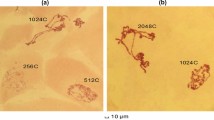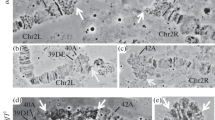Abstract
A systematic screen of wild-type Drosophila melanogaster larval organs has revealed three tissues besides the salivary gland with suitable polyteny for detailed cytogenetic analysis: the prothoracic gland, hindgut, and middle midgut. Chromosome banding patterns are very similar between tissues, but puffing patterns show considerable differences. In intact nuclei, oblique substructural elements can sometimes be detected in bands from some of the tissues. As a way of exploiting these newly characterized chromosomes, the heat shock puff response in midgut cells has been studied in detail. The puffing pattern is very similar to that in salivary glands, but an unexpected difference is found in the relative activity of the 87A7 and 87C1 loci, which contain the hsp70 genes. When larvae are raised at 16° C, heat shocks ranging from 10 to 60 min induce only a weak midgut puff at 87A7 that is much smaller than that at 87C1, in contrast to other tissues where both are strongly induced. In pulse-labeled nuclei, an approximately five fold difference in transcriptional activity at the two loci is observed. However, when larvae are raised at 25° C, the converse is found: the 87A7 puff is large, and little or no puffing is detectable at 87C1. Thus, in the midgut, heat shock induced puffing at these two loci is inversely modulated by a mechanism dependent on growth temperature.
Similar content being viewed by others
References
Ashburner M (1970) Patterns of puffing activity in the salivary gland chromosomes of Drosophila. V. Responses to environmental treatments. Chromosoma 31:356–376
Ashburner M (1972) Puffing patterns in Drosophila melanogaster and related species. In: Beermann W (ed) Developmental studies on giant chromosomes. Results and problems in differentiation, vol 4. Springer, Berlin Heidelberg New York, pp 101–151
Ashburner M, Bonner JJ (1979) The induction of gene activity in Drosophila by heat shock. Cell 17:241–254
Beermann W (1952) Chromosomenstruktur und spezifische Modifikation der Chromosomenstruktur in der Entwicklung und Organdifferenzierung von Chironomus tentans. Chromosoma 5:139–198
Berendes HD (1965) The induction of changes in chromosomal activity in different polytene types of cell in Drosophila hydei. Dev Biol 11:371–384
Berendes HD (1966) Gene activities in the malphigian tubules of Drosophila hydei at different developmental stages. J Exp Zool 162:209–218
Bonner JJ, Pardue ML (1976) The effect of heat shock on RNA synthesis in Drosophila tissues. Cell 8:43–50
Bridges CB (1935) Salivary chromosome maps. J Hered 26:60–64
Brown AJL, Ish-Horowicz D (1981) Evolution of the 87A and 87C heat-shock loci in Drosophila. Nature 290:677–682
Burgoyne LA, Wagar MA, Atkinson MR (1971) Calcium dependent priming of DNA synthesis in isolated rat liver nuclei. Biochem Biophys Res Commun 39:254–259
Craig EA (1984) The heat shock response. CRC Crit Rev Biochem 18:239–280
Hochstrasser M, Sedat JW (1987) Three-dimensional organization of Drosophila melanogaster interphase nuclei: I. Tissue specific aspects of polytene nuclear architecture. J Cell Biol 104, in press
Hochstrasser M, Mathog D, Gruenbaum Y, Saumweber H, Sedat JW (1986) Spatial organization of chromosomes in the salivary gland nuclei of Drosophila melanogaster. J Cell Biol 102:112–123
Hochstrasser M, Mathog D, Gruenbaum Y, Saumweber H, Sedat JW (1987) Three-dimensional organization of interphase chromosomes in polytene nuclei of Drosophila melanogaster. In: Kahl G (ed) Architecture of eukaryotic genes. Verlag Chemie, Weinheim, in press
Holden JJ, Ashburner M (1978) Patterns of puffing activity in the salivary gland chromosomes of Drosophila. IX. The salivary and prothoracic gland chromosomes of a dominant temperature sensitive lethal of D. melanogaster. Chromosoma 68:205–227
Ish-Horowicz D, Pinchin SM, Gausz J, Gyurkovics H, Bencze G, Goldschmidt-Clermont M, Holden JJ (1979) Deletion mapping of two D. melanogaster loci that code for the 70,000 dalton heat-induced protein. Cell 17:565–571
Kaufman BP, Iddles MK (1963) Distributional pairing in salivary gland chromosomes of Drosophila melanogaster (I. Distributional patterns in relation to puffing). Port Acta Biol A7:225–248
Kress H, Meyerowitz EM, Davidson N (1985) High resolution mapping of in situ hybridized biotinylated DNA to surfacespread Drosophila polytene chromosomes. Chromosoma 93:113–122
Laird CD, Ashburner M, Wilkinson L (1980) Relationship between relative dry mass and average band width in regions of polytene chromosomes of Drosophila. Chromosoma 76:175–189
Lakhotia SC, Mukherjee T (1980) Specific activation of puff 93D of Drosophila melanogaster by benzamide and the effect of benzamide treatment on the heat shock induced puffing activity. Chromosoma 81:125–136
Lakhotia SC, Singh AK (1985) Non-inducibility of the 93D heatshock puff in cold-reared larvae of Drosophila melanogaster. Chromosoma 92:48–54
Lefevre G (1976) A photographic representation and interpretation of the polytene chromosomes of Drosophila melanogaster salivary glands. In: Ashburner M, Novitski E (eds) The genetics and biology of Drosophila, vol 1 A. Academic Press, New York, pp 31–66
Lindsley DL, Grell EH (1968) Genetic variations of Drosophila melanogaster. Carnegie Inst Wash Publ, p 627
Mathog D, Hochstrasser M, Gruenbaum Y, Saumweber H, Sedat J (1984) Characteristic folding pattern of the polytene chromosomes in Drosophila salivary gland nuclei. Nature 308:414–421
Mohler J, Pardue ML (1984) Mutational analysis of the region surrounding the 93D heat shock locus of Drosophila melanogaster. Genetics 106:249–265
Mortin LI, Sedat JW (1982) Structure of Drosophila polytene chromosomes. Evidence for a toroidal organization of the bands. J Cell Sci 57:73–113
Pavan C, Breuer ME (1952) Polytene chromosomes in different tissues of Rhynchosciara. J Hered 43:152–157
Poulson DF, Waterhouse DF (1960) Experimental studies on pole cells and midgut differentiation in Diptera. Aust J Biol Sci 13:541–567
Richards G (1980) The polytene chromosomes in the fat body nuclei of Drosophila melanogaster. Chromosoma 79:241–250
Richards G (1982) Sequential gene activation by ecdysteroids in polytene chromosomes of Drosophila melanogaster. VII. Tissue specific puffing. Wilhelm Roux Archiv Entwicklungsmech Org 191:103–111
Ritossa F (1962) A new puffing pattern induced by heat shock and DNP in Drosophila. Experientia 18:571–573
Ritossa FM (1964) Experimental activation of specific loci in polytene chromosomes of Drosophila. Exp Cell Res 35:601–607
Saumweber H, Symmons P, Kabisch R, Will H, Bonhoeffer F (1980) Monoclonal antibodies against chromosomal proteins of Drosophila melanogaster. Chromosoma 80:253–275
Semeshin VF, Baricheva E, Belyaeva ES, Zhimulev IF (1982) Electron microscopical analysis of Drosophila polytene chromosomes. I. Mapping of the 87A and 87C heat shock puffs in development. Chromosoma 87:229–237
Semeshin VF, Belyaeva ES, Zhimulev IF, Lis JT, Richards G, Bourouis M (1986) Electron microscopical analysis of Drosophila polytene chromosomes. IV. Mapping of morphological structures appearing as a result of transformation of DNA sequences into chromosomes. Chromosoma 93:461–468
Shield G, Sang JH (1970) Characteristics of five cell types appearing during in vitro culture of embryonic material from Drosophila melanogaster. J Embryol Exp Morphol 23:53–69
Simon JA, Sutton CA, Lis JT (1985) Localization and expression of transformed DNA sequences within heat shock puffs of Drosophila melanogaster. Chromosoma 93:26–30
Strasburger M (1932) Bau, Funktion und Variabilität des Darmtractus von Drosophila melanogaster Meigen. Z Wiss Zool 140:539–649
Udvardy A, Maine E, Schedl P (1985) The 87A7 chromomere. Identification of novel chromatin structures flanking the heat shock locus that may define the boundaries of higher order domains. J Mol Biol 185:341–358
Wu C (1980) The 5′ ends of Drosophila heat shock genes in chromatin are hypersensitive to DNase I. Nature 286:854–860
Zhimulev IF, Belyaeva ES (1975) 3H-uridine labeling patterns in the Drosophila melanogaster-salivary gland chromosomes X, 2L and 3L. Chromosoma 49:219–231
Zhimulev IF, Belyaeva ES, Semeshin VF (1981) Informational content of polytene chromosome bands and puffs. CRC Crit Rev Biochem 11:303–340
Zhimulev IF, Semeshin VF, Kulchicov VA, Belyaeva ES (1982) Intercalary heterochromatin in Drosophila. I. Localization and general characteristics. Chromosoma 87:197–228
Author information
Authors and Affiliations
Rights and permissions
About this article
Cite this article
Hochstrasser, M. Chromosome structure in four wild-type polytene tissues of Drosophila melanogaster . Chromosoma 95, 197–208 (1987). https://doi.org/10.1007/BF00330351
Received:
Revised:
Issue Date:
DOI: https://doi.org/10.1007/BF00330351




